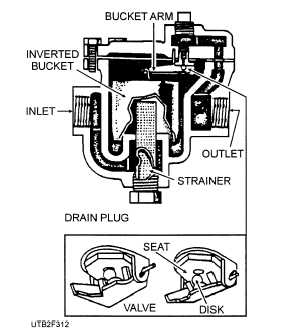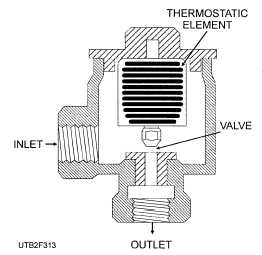
Figure 3-12. - An inverted bucket trap.
BUCKET TRAP. - There are two types of bucket traps: the upright and the inverted. An example of the inverted bucket trap is shown in figure 3-12.
During operation of the upright bucket trap, the steam and water both enter the trap body. As the water enters, it causes the bucket to float and the valve to close. The water continues to rise; it overflows into the bucket that sinks. When the bucket sinks, the trap valve is opened and the steam pressure forces the water out. When all of the water is expelled from the bucket, the bucket again floats, the valve closes, and the cycle starts again.
During the operation of the inverted bucket trap, the steam and water both enter under the bucket. The steam makes the bucket buoyant, causes it to rise, and closes the valve. When the steam condenses, the bucket drops, opens the valve, and the steam blows the water out of the trap.
Maintenance on bucket traps consists mainly of cleaning and inspecting them periodically. If the trap begins to leak steam, replace the valve disk and seat. However, if the bucket fails to open the valve, the trap usually becomes waterlogged. When a valve disk or seat becomes damaged, the trap allows steam to leak through. The condensate return line becomes excessively hot when the trap is leaking steam. Bucket traps contain some water at all times. Therefore, they must be drained when the system is to be off during freezing weather.

Figure 3-13. - A typical thermostatic trap.
THERMOSTATIC TRAP. - The thermostatic trap is often used on radiators and is commonly known as a radiator trap. It has a bellows that contains volatile fluid that expands and vaporizes when heated. Pressure builds up inside the bellows and causes it to lengthen and close the valve. A typical thermostatic trap is shown in figure 3-13.
When water collects around and cools the bellows, the bellows contracts. This action opens the valve and permits water to escape. As the water goes out, the steam that enters contacts the bellows and causes it to expand, closing the valve and preventing the steam from escaping.
The most common trouble with the thermostatic trap is that the bellows develops holes. So, the bellows does not work and has to be replaced. The bellows and lower valve seat can be removed for repair without disconnecting any of the piping.
FLOAT THERMOSTATIC TRAP. - The float thermostatic trap operates on the principle of the float trap and the thermostatic trap. Practically the same maintenance is required. A typical example of the float thermostatic trap is shown in figure 3-14. The thermostatic bellows acts as an air eliminator.
IMPULSE TRAP. - The operation of the- impulse trap (fig. 3-15) is based on the principle that a portion of hot water, under pressure, flashes into steam when its pressure is reduced. The trap is operated by a moving valve impelled by changes of pressure in a control chamber. The valve has tiny orifices drilled through its center that allow the continuous bypassing of condensate from the inlet of the trap to the control chamber. This bypassing reduces the chamber pressure below the inlet pressure, so the valve opens and allows
Continue Reading